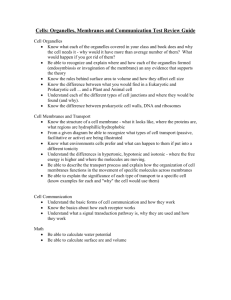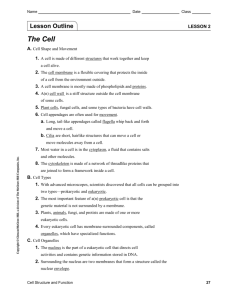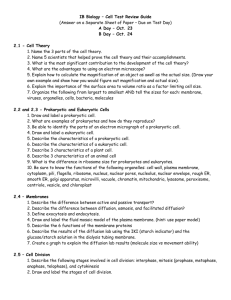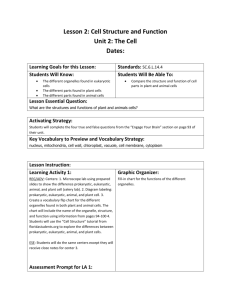Eukaryotic cells
advertisement
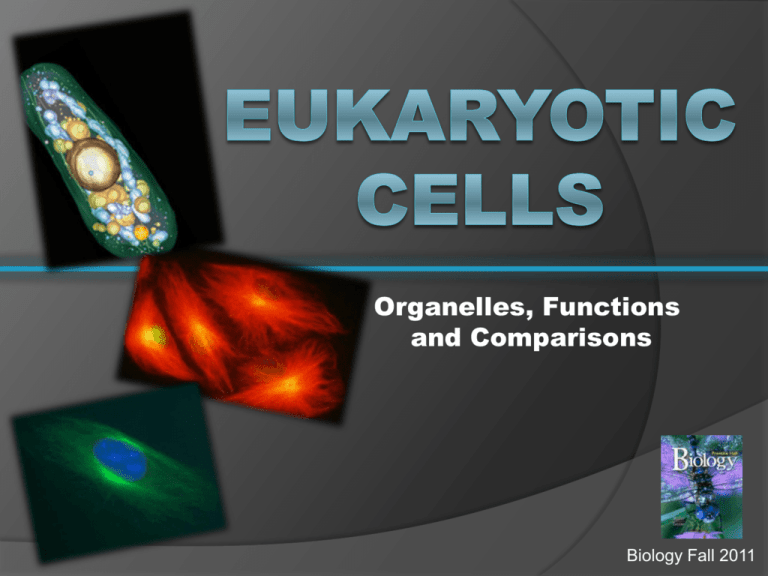
Organelles, Functions and Comparisons Biology Fall 2011 We will discuss… Basic Information Description of Cells Meet the Organelles Examples of Eukaryotic Cells Prokaryotic Vs. Eukaryotic Vocabulary Today’s Activity References Basic Information (from the Greek meaning truly nuclear) These cells have a nucleus 10 times greater in size than Prokaryotic Cells comprise all of the life kingdoms except Monera (Protista, Plantae, Fungi and Animalia) contain many internal membrane-bound structures called organelles Plasma Membrane is present Two Types of Cells Animal Plant Description of Cell Animal Cell Contains a number of organelles to help with its function Found in Humans and Animals Centrioles are present ○ Not found in Plant Cells Description of Cell (cont.) Plant Cell Functions similar to an Animal Cell ○ Most of the Organelles are present 3 unique structures ○ Plastids ○ Cell Walls ○ Vacuoles Meet the Organelles… and their Functions A lipid/protein/carbohydrate complex, providing a barrier and containing transport and signaling systems. Double membrane surrounding the chromosomes and the nucleolus. Pores allow specific communication with the cytoplasm. The nucleolus is a site for synthesis of RNA making up the ribosome Surrounded by a double membrane with a series of folds called cristae. Functions in energy production through metabolism. Contains its own DNA Meet the Organelles (cont.) Contains stacked thylakoid membranes. Responsible for photosynthesis, Contains DNA similar to Mitochondria A network of interconnected membranes forming channels within the cell. Covered with ribosomes (causing the "rough" appearance) A network of interconnected membranes forming channels within the cell. A site for synthesis and metabolism of lipids Meet the Organelles A series of stacked membranes. Vesicles (small membrane surrounded bags) carry materials from the RER to the Golgi apparatus. Vesicles move between the stacks while the proteins are "processed" to a mature form. Vesicles then carry newly formed membrane and secreted proteins to their final destinations A membrane bound organelle that is responsible for degrading proteins and membranes in the cell, and also helps degrade materials ingested by the cell. (cont.) Membrane surrounded "bags" that contain water and storage materials in plants. Produce and degrade hydrogen peroxide, a toxic compound that can be produced during metabolism. Examples of Eukaryotic Cells Centric Diatom Kingdom: Protista Bread Yeast- S. cerevisiae Kingdom: Fungi Examples (cont.) Pea Leaf Stomata Kingdom: Plantae Golden Colonia Algae-Synura Kingdom: Protista Examples (cont.) Sunflower Petal and Pollen Grain Kingdom: Plantae Human Breast Cancer Cell Kingdom: Animalia Examples (cont.) Human Red Blood Cells, Platelets and T-Lymphocytes Kingdom: Animalia Human Liver Cell Kingdom: Animalia Prokaryotes Vs. Eukaryotes Similarities?!? Both prokaryotic cells and eukaryotic cells have ribosomes. Both prokaryotic cells and eukaryotic cells have a plasma membrane. Both prokaryotic cells and eukaryotic cells have cytoplasm. Both prokaryotic cells and eukaryotic cells have DNA. Differences No Structured Nucleus Present No Organelles present Simpler structures Cell Wall Present Nucleus Present Organelles Present Complex structure Cell wall may or may not be present. #TeamProkaryote #TeamEukaryote The Comparison Vocabulary Words Nucleus Nucleolus Golgi Apparatus Lysosome Cytosol Perixisome Centromere Centriole Cell Membrane Secretory Vesicle Mitochondrion Vacuole Cell Wall Chloroplast Ribosomes Cytoskeleton Smooth Endoplasmic Reticulum Rough Endoplasmic Reticulum Today’s Activity… Virtual Lab and Color Worksheet Go to the website http://www.cellsalive.com/cells/cell_model.ht m Part A:Use cell models found on the website to define the vocabulary words from the presentation. On reverse side of the paper, draw a picture of both a plant and animal cells for your notes. Make sure to distinguish the differences between the two! Today’s Activity (cont.) Part B: Complete the “Eukaryotic Cell” color sheet. Use map pencils or crayon (no markers or pens) Match the organelle found in the cell with the correct name. Both assignments are due at the end of the class period. Questions? References http://library.thinkquest.org/C004535/euk aryotic_cells.html http://biology.kenyon.edu/HHMI/Biol113/ eukaryoticcells.htm http://www.cellsalive.com/cells/cell_mod el.htm http://www.biology.arizona.edu/cell_bio/t utorials/pev/page3.html


